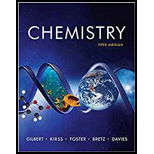
(a)
Interpretation: Two different images showing different arrangement of particles is given. The class of matter (an element, a compound, a homogenous mixture, or a heterogeneous mixture) and the physical state in the given images is to be stated.
Concept introduction: The space between the particles of solids is very less, so they just vibrate at their own place, while the specie between the particles of liquid is more as compared to solids. The space between particles of gas is very large so they can easily move and collide with each other and with the walls of the container.
When the atoms belonging to different elements are chemically combined in a fixed ratio then it leads to the formation of a compound while when the atoms of same type are combined together then it leads to the formation of an element.
The homogeneous mixture consists of same uniform composition and appearance throughout the mixture while the heterogeneous mixture has non-uniform composition throughout the mixture.
To determine: The class of matter (an element, a compound, a homogenous mixture, or a heterogeneous mixture) and the physical state in the given image.
(a)
Answer to Problem 1.1VP
Solution
The given image shows that the species present inside the box is a pure compound and is present in the gaseous state.
Explanation of Solution
Explanation
The given image shows that the species present inside the box is a pure compound because it consists of only red and blue balls that are combined together. It consists of only two types of elements that are joined together; therefore it is not a homogeneous mixture. As it is seen that the space between the compounds is very large and they are free to move in the entire space, it means it represent the gaseous state.
(b)
To determine: The class of matter (an element, a compound, a homogenous mixture, or a heterogeneous mixture) and the physical state in the given image.
(b)
Answer to Problem 1.1VP
Solution
The given image shows that the species present inside the box is a homogeneous mixture and is present in gaseous state.
Explanation of Solution
Explanation
The given image shows that the species present inside the box is a homogeneous mixture. It consists of two different balls that represent the elements. As two balls of a particular color are joined together, therefore, they form a molecule. As these two different molecules are uniformly distributed, therefore, the given mixture is homogeneous. As it is seen that there is a large space between the different molecules so that they are free to rotate. Therefore, the given molecules are in gaseous state.
Conclusion
The shape of matter depends on the arrangement of particles from which the matter is made up of that is whether it is solid, liquid or gas
Want to see more full solutions like this?
Chapter 1 Solutions
CHEMISTRY:SCI.IN CONTEXT (CL)-PACKAGE
- Can I please get help with this? And can I please the lowest possible significant number?arrow_forwardWhat is the molar mass of a gas that takes three times longer to effuse than helium?arrow_forwardFirst image: I have to show the mecanism (with arows and structures) of the reaction at the bottom. Also I have to show by mecanism why the reaction wouldn't work if the alcohol was primary Second image: I have to show the mecanism (with arrows and structures) for the reaction on the left, where the alcohol A is added fast in one portion its not an examarrow_forward
- what is the skeletal structure of a tertiary alkyl fluoride with six carbon atoms and no rings.arrow_forwardOne step of glycolysis is a retro-aldol reaction (aldolase) to produce ATP.Below is the aldol reaction of the equilibrium. Show the mechanism for the base catalyzed reaction. *see imagearrow_forwardProvide the missing information. *see imagearrow_forward
- Provide the missing information. *see imagearrow_forwardProvide the missing information. *see imagearrow_forwardDraw the mechanism (including all curved arrows for electron movement) showing how the maleicanhydride is attacked by the anthracene and formation of the final Diels Alder product.arrow_forward
 ChemistryChemistryISBN:9781305957404Author:Steven S. Zumdahl, Susan A. Zumdahl, Donald J. DeCostePublisher:Cengage Learning
ChemistryChemistryISBN:9781305957404Author:Steven S. Zumdahl, Susan A. Zumdahl, Donald J. DeCostePublisher:Cengage Learning ChemistryChemistryISBN:9781259911156Author:Raymond Chang Dr., Jason Overby ProfessorPublisher:McGraw-Hill Education
ChemistryChemistryISBN:9781259911156Author:Raymond Chang Dr., Jason Overby ProfessorPublisher:McGraw-Hill Education Principles of Instrumental AnalysisChemistryISBN:9781305577213Author:Douglas A. Skoog, F. James Holler, Stanley R. CrouchPublisher:Cengage Learning
Principles of Instrumental AnalysisChemistryISBN:9781305577213Author:Douglas A. Skoog, F. James Holler, Stanley R. CrouchPublisher:Cengage Learning Organic ChemistryChemistryISBN:9780078021558Author:Janice Gorzynski Smith Dr.Publisher:McGraw-Hill Education
Organic ChemistryChemistryISBN:9780078021558Author:Janice Gorzynski Smith Dr.Publisher:McGraw-Hill Education Chemistry: Principles and ReactionsChemistryISBN:9781305079373Author:William L. Masterton, Cecile N. HurleyPublisher:Cengage Learning
Chemistry: Principles and ReactionsChemistryISBN:9781305079373Author:William L. Masterton, Cecile N. HurleyPublisher:Cengage Learning Elementary Principles of Chemical Processes, Bind...ChemistryISBN:9781118431221Author:Richard M. Felder, Ronald W. Rousseau, Lisa G. BullardPublisher:WILEY
Elementary Principles of Chemical Processes, Bind...ChemistryISBN:9781118431221Author:Richard M. Felder, Ronald W. Rousseau, Lisa G. BullardPublisher:WILEY





